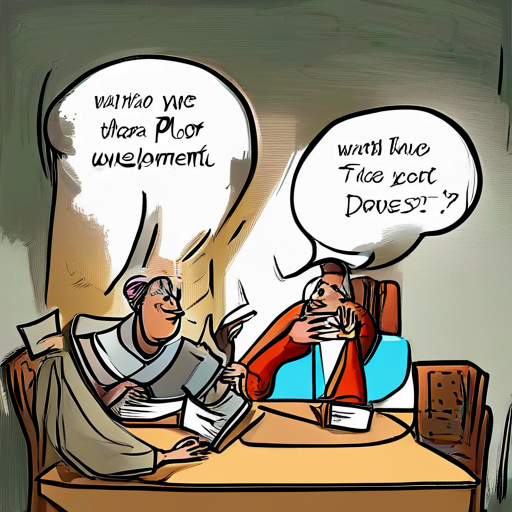Are you curious about the way dialogue functions in literature? Do you want to understand how it contributes to developing plot, character, themes, and meanings in a literary work? Then, this article is for you!
Analyzing the role of dialogue is a critical aspect of literary analysis, which allows you to grasp the subtle nuances of a text and appreciate its literary merit.
Dialogue is the spoken or written exchange between characters in a literary work. It is a crucial component of storytelling that adds depth, complexity, and authenticity to the narrative. Dialogue enables authors to convey their ideas, emotions, and messages through the voices of their characters, creating a dynamic interplay of language and meaning.
Therefore, analyzing dialogue in a literary work can offer insights into the author’s intentions, the characters’ motivations, and the themes’ significance, enabling you to appreciate the work’s literary value.
Table of Contents
Definition and Importance of Dialogue in Literature

Understanding the significance of characters’ conversations is vital for creating a captivating narrative. Dialogue is an essential aspect of literature that allows readers to understand the characters’ personalities, motivations, and relationships with each other. It is through the words they speak that we can gain insight into their thoughts and emotions.
Dialogue isn’t just about the words spoken, but also about how they’re spoken. The tone, pace, and inflection of the characters’ voices can reveal their attitudes and feelings towards each other. By paying attention to the dialogue, readers can also infer the characters’ social status, education level, and cultural background.
Therefore, dialogue is not just a tool for conveying information, but also for creating a rich and complex literary world that readers can immerse themselves in.
Development of Plot through Dialogue

You’ll see how conversations between characters drive the story forward and keep you engaged in what’s happening. Dialogue is more than just a way for characters to communicate with each other. It’s a tool that authors use to develop their plot and characters.
Through dialogue, an author can reveal backstory, create conflict, and advance the plot. For example, let’s say you’re reading a mystery novel. The protagonist is interviewing a suspect, and the suspect denies any involvement in the crime. However, the protagonist notices a nervous tick in the suspect’s speech and decides to dig deeper.
This interaction between the two characters not only reveals important information about the plot but also creates tension and suspense, keeping the reader engaged in the story. Without dialogue, the plot would be stagnant, and the characters would remain one-dimensional.
Character Development through Dialogue

Discover how authors use conversations between characters to create dynamic and relatable personalities in their stories. Dialogue is a powerful tool that allows readers to get to know the characters in a literary work. Through their words and interactions, authors can reveal a character’s personality, motivations, and beliefs. They can also show how a character changes over time, and how they react to different situations.
For example, in Jane Austen’s Pride and Prejudice, the dialogue between Elizabeth Bennet and Mr. Darcy reveals their personalities and their relationship. Initially, they have a contentious relationship, and their conversations are full of witty banter and insults. However, as they get to know each other better, their conversations become more meaningful and heartfelt.
By the end of the novel, they have developed a deep understanding and respect for each other, which is evident in their final conversation. Through their dialogue, Austen creates two complex and multifaceted characters who are both flawed and loveable.
Language and Tone in Dialogue

When writing dialogue, you have the power to establish the setting and atmosphere of your story. Through the use of descriptive language and carefully selected words, you can create a vivid picture of the world your characters inhabit.
Additionally, language and tone are essential tools for creating mood and tone. By choosing the right words and inflection, you can convey a wide range of emotions and attitudes, from humor and warmth to tension and hostility.
So, don’t be afraid to use contractions to make your dialogue sound more natural and authentic. Just make sure that your characters’ language and tone match their personalities and the situation they’re in. With a little bit of practice, you can master the art of writing convincing dialogue that engages your readers and brings your story to life.
Establishing Setting and Atmosphere
As you read, you’ll feel transported to the world of the story as the author skillfully sets the scene and creates a vivid atmosphere through descriptive language and sensory details.
Dialogue plays a crucial role in this process by establishing the setting and mood of each scene. Whether it’s the bustling city streets of New York or the serene countryside of England, the characters’ words and actions give the reader a sense of place and time.
The way characters speak can also add to the overall atmosphere of the story. A tense exchange between two characters in a dimly lit room creates a different feeling than a lighthearted conversation in a sunny park.
The setting and atmosphere are not just a backdrop for the story, but integral parts of the narrative that affect the characters and their actions. By paying attention to the dialogue, the reader can better understand the world of the story and the emotions of the characters within it.
Creating Mood and Tone
Get ready to feel the emotions of the story as the author sets the mood and tone through descriptive language and the characters’ actions, immersing you in their world.
The mood of a literary work refers to the overall emotional atmosphere or feeling that the author creates. This can be achieved through the setting, dialogue, and even the choice of words.
The tone, on the other hand, is the author’s attitude towards the subject matter or the characters. It can be conveyed through the dialogue and the actions of the characters.
Through dialogue, the author can create a sense of tension or calmness, depending on the situation. For example, if the characters are having a heated argument, the author may use short, sharp sentences to create a sense of urgency. If the characters are in a peaceful setting, the author may use longer, more descriptive sentences to create a sense of relaxation.
By using dialogue to create mood and tone, the author can make the reader feel more connected to the story and the characters.
Themes and Meanings Revealed through Dialogue

You can gain insight into the underlying themes and meanings of a story by paying close attention to the conversations between its characters. Dialogue offers a window into the characters’ minds and emotions, revealing their motivations, fears, and desires. By analyzing the language and tone of the characters’ interactions, you can uncover the deeper messages and ideas that the author is trying to convey.
For example, in a story about love and loss, the characters’ conversations may reveal the different ways that people cope with grief, or the complex dynamics of a troubled relationship. Dialogue can also provide a powerful commentary on societal issues, such as racism, inequality, or political corruption. By examining the words and actions of the characters, you can gain a deeper understanding of the author’s perspective on these issues, and the message they are trying to convey to the reader.
Moreover, dialogue can be a tool for creating tension and conflict within a story. When characters have opposing viewpoints or agendas, their conversations can escalate into heated arguments or emotional confrontations. This not only adds excitement and drama to the plot, but also reveals the underlying tensions and power struggles that exist within the story.
By analyzing the language and tone of these conversations, you can gain a deeper understanding of the characters’ motivations and the obstacles they must overcome. Dialogue can also be used to create a sense of intimacy or connection between characters, revealing the bonds of friendship, family, or romance that exist within the story.
By paying attention to the subtleties of the characters’ conversations, you can gain a more nuanced understanding of the themes and meanings that the author is trying to convey.
Examples of Effective Dialogue in Literature

Take a look at how authors use conversations between characters to reveal themes and add tension and intimacy to their stories.
One great example of effective dialogue in literature is the opening scene of J.D. Salinger’s ‘The Catcher in the Rye.’ The conversation between Holden Caulfield and his history teacher, Mr. Spencer, reveals Holden’s character and sets the tone for the rest of the novel. Through their conversation, we learn that Holden is disillusioned with the world around him and struggling with his own sense of identity. The dialogue is also effective in building tension as Mr. Spencer attempts to impart wisdom onto Holden, but Holden is unwilling to listen.
Another example of effective dialogue can be found in William Golding’s ‘Lord of the Flies.’ The conversations between the boys on the island reveal their personalities and their descent into savagery. The dialogue is particularly effective in showing the power dynamics between the characters, such as when Jack tries to take control of the group through his persuasive words. The dialogue also adds intimacy to the story, as the boys confide in each other and reveal their fears and desires.
Overall, the dialogue in ‘Lord of the Flies’ adds depth to the characters and contributes to the novel’s exploration of human nature.
Tips for Analyzing Dialogue in Literature

If you’re looking to dive deeper into the conversations between characters in your favorite novels, these tips will help you understand how authors use dialogue to reveal themes and add tension to their stories.
The first thing to look for is the purpose of the dialogue. Is it advancing the plot, revealing character, or providing exposition? Once you identify the purpose, examine the language used by the characters. Are they using formal language or slang? Is the tone friendly or hostile? These choices can reveal a lot about the characters and their relationships.
Another important aspect of analyzing dialogue is paying attention to what’s not said. Authors often use subtext to create tension and conflict between characters. Look for moments where the characters are saying one thing but meaning another. This can be especially effective in revealing underlying emotions or motivations.
Finally, consider the larger context of the dialogue. How does it fit into the overall story? Does it support the themes or contradict them? By examining the purpose, language, subtext, and context of dialogue, you can gain a deeper understanding of the role it plays in a literary work.
Frequently Asked Questions
What is the difference between dialogue and monologue in literature?
When it comes to literature, dialogue and monologue are two distinct forms of communication between characters. Dialogue involves a conversation between two or more characters, while monologue involves a single character speaking their thoughts aloud.
In dialogue, there is often a back-and-forth exchange between characters that reveals their personalities, motivations, and relationships. Monologue, on the other hand, allows for deeper insight into a character’s inner thoughts and emotions.
Both forms of communication can be effective in conveying meaning and advancing the plot, but they serve different purposes. Understanding the difference between dialogue and monologue is crucial for interpreting the nuances of a literary work.
How does a writer determine which characters should have dialogue in a scene?
When you’re deciding which characters should have dialogue in a scene, there are several factors to consider.
First, think about the purpose of the scene and what you want to accomplish through dialogue. Are you trying to reveal something about the characters, move the plot forward, or create tension?
Once you know what you’re trying to achieve, think about which characters are best suited to accomplish that goal. Is there a character who has a personal stake in the outcome, or one who has information that’s crucial to the story?
Remember that dialogue should be used strategically, and not every character needs to speak in every scene. By carefully selecting who speaks, you can create a more dynamic and engaging story.
Can dialogue be used to convey symbolism or metaphor in a literary work?
When reading a literary work, dialogue isn’t just a means of conveying information and advancing the plot, but a powerful tool for conveying symbolism and metaphor. By carefully analyzing the words spoken by the characters, you can uncover deeper meanings and hidden themes that the author is trying to convey.
For example, a character’s use of certain words or phrases may reflect their personality traits or emotional state, while the tone and cadence of their speech can reveal their relationship with other characters. In addition, dialogue can be used to convey larger themes and ideas, such as social commentary or political critique, through the interactions between characters.
By paying close attention to the nuances of dialogue, you can gain a deeper understanding of the literary work and appreciate the artistry of the writer’s craft.
What is the significance of nonverbal communication in dialogue?
Have you ever noticed how much can be conveyed in a conversation without actually saying anything? That’s the power of nonverbal communication in dialogue.
A simple gesture, a pause, or a change in tone can completely alter the meaning of a conversation. It’s not always what is said, but how it is said that carries the most weight.
In literature, nonverbal communication can add depth and complexity to a character’s personality or relationships. It can also be used to create tension or to foreshadow future events.
When analyzing a literary work, it’s important to pay attention to not only what characters say, but also how they say it.
How does the cultural context of a literary work affect the use and interpretation of dialogue?
When considering the use and interpretation of dialogue in a literary work, it’s essential to examine the cultural context in which it was written.
The language, customs, and beliefs of a particular society can greatly impact the way characters communicate with one another and the underlying meanings behind their words.
For example, in a collectivist culture, dialogue may prioritize harmony and group cohesion over individual expression, while in an individualistic culture, dialogue may emphasize personal autonomy and self-expression.
Additionally, historical events and political climates can shape the language and tone of dialogue, revealing the attitudes and values of a particular time period.
Therefore, analyzing the cultural context of a literary work is crucial in understanding the nuances and complexities of dialogue within the text.
Conclusion
As you reach the end of this article, you’ve learned that dialogue is an essential element of literature. It serves a crucial purpose in the development of plot and characters, as well as revealing themes and meanings.
Effective dialogue can bring a story to life and create a sense of realism that engages readers. By analyzing dialogue in literature, you can gain a deeper understanding of the author’s intentions and the significance of each character’s words.
You can also appreciate the nuances of language and tone and how they contribute to the overall effect of the work. With the tips provided, you can hone your skills in analyzing dialogue and gain a greater appreciation for the power of language in literature.
So go ahead and read your favorite book with a new perspective, and see how dialogue shapes the story you love.
